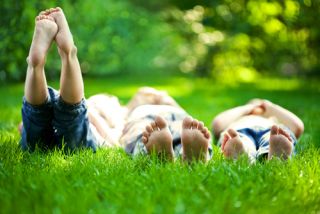Play
Outdoor Living and the Shrinking Backyard
Stating the case for a backyard space.
Posted June 19, 2013

We live in a small house. It may not be small by New York City standards, but it is smaller than most of the homes I’ve known.
The limited space in our living area, combined with two boisterous toddlers, has recently prompted us to overhaul our garden. Although this area currently consists of sand, rock and rubble, we have visions of a grassed area for backyard ball games, trees for shaded play, and raised vegetable garden beds. Fortunately, we have the space to create this.
Given our situation, I have been questioning the merits of prioritizing spacious gardens over indoor living areas. Notably, our lifestyle preferences and local climate support outdoor living. Personally, I’d rather spend an afternoon weeding a garden bed than scrubbing a bathroom. Hence our one bathroom abode suits me well. I also live in a part of Australia with a Mediterranean climate, meaning our outdoor spaces can be enjoyed throughout the year.
Yet even when compared with others in my city, my preference for outdoor rather than indoor living seems to place me in the minority. There is an undeniable trend in Australia towards larger houses and smaller lots.1 While lot sizes are most definitely shrinking, our diminishing backyards have been attributed more to increasing house size (despite smaller families), suggesting that many people value indoor areas over outdoor gardens.1
There are a number of benefits to having a backyard. Previous posts of mine have noted associations between views of nature and both mental restoration and stress relief. In a paper dedicated to shrinking backyards, Professor Tony Hall reports that backyards have been associated with greater biodiversity, the management of storm water, regulating indoor temperatures and reducing related energy use.1
In addition, studies have found a positive association between larger backyards and physical activity in preschool children, with evidence suggesting that public open space may not compensate for a small or absent backyard for children of this age.2 While I am an unabashed advocate of public open space and reducing urban sprawl, I’m conscious that backyards can provide a greater degree of privacy and security.1 As a parent, I would much prefer my children play outdoors while I prepare their dinner than watch television. Given their young age, I’d rather my toddlers do this in the backyard where I can see them than a park down the street.
Admittedly, I have often lamented our lack of indoor storage space and the noise and privacy constraints that accompany small spaces. For me, these are minor complaints. Perhaps as our family’s needs evolve and our toddlers turn into teenagers, we will reassess our living situation and rethink our emphasis on outdoor rather than indoor living. That being said, if given the luxury of a free-standing home, I imagine I will always sacrifice indoor space for an outdoor area, no matter how small it might be.
References
- Tony H. Goodbye to the Backyard?—The Minimisation of Private Open Space in the Australian Outer-Suburban Estate. Urban Policy and Research. 2010; 28(4):411-433.
- Spurrier NJ, Magarey A, Golley R, Curnow F, Sawyer MG. Relationships between the home environment and physical activity and dietary patterns of pre-school children: a cross-sectional study. International Journal of Behavioral Nutrition and Physical Activity. 2008; 5(31), published online.


